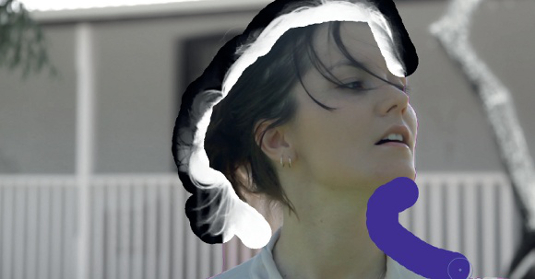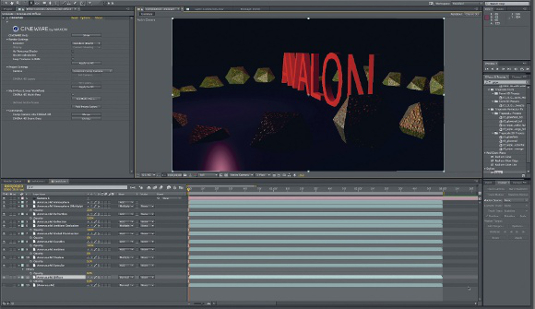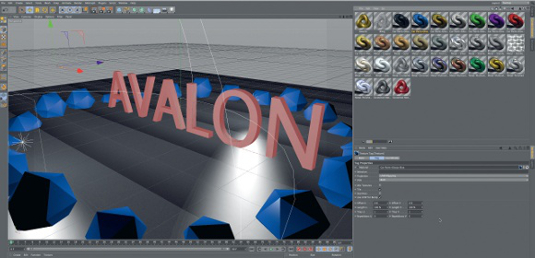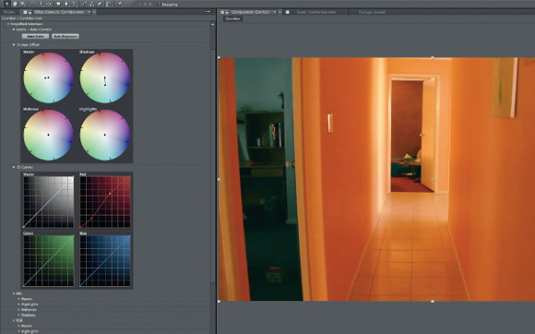Why you can trust Creative Bloq
- PRICE: £14.65 per month
- OPERATING SYSTEM: Windows / Mac OS X
FEATURES
- Create complex graphics with layer-based effects
- Refine Edge to add transparency to difficult masks, such as hair
- Live Cinema 4D pipeline to render 3D models inside After Effects
- Warp Stabilizer VFX to track effects into moving footage
- 3D tracking to add objects and text to moving shots
DEVELOPER: Adobe
Some people call After Effects the Photoshop of the video-editing world, but it does more than manipulate your images. You can use After Effects to create movie-style visual effects, perform colour correction, create title sequences and motion graphics, and even add 3D models to your scenes. The new release will feel familiar to current users, but it has a much richer set of 3D tools.
The interface in After Effects is similar to that in Premiere or Photoshop. By combining layers with different blending modes and applying filters and masks, you create your final output. Getting to grips with the basics of After Effects is quite simple, but becoming an advanced user takes some training, and this is even more noticeable with the integration of more complex 3D.

3D layers have been available in After Effects for many years, and motion graphics designers have made great use of the ability to arrange 2D layers in 3D space. In the previous release, raytraced 3D text was introduced, so that users could drop 3D text directly into their scenes. It was then possible to fly an After Effects camera through a basic 3D scene. In this release, this concept has been taken much further by introducing a direct pipeline to a 3D package.
Cinema 4D Lite is now bundled with After Effects, meaning you can create 3D scenes or models in Cinema 4D, and have them update immediately in your After Effects timeline. In practical terms, this means that creating complex text animations is much easier, if you know your way around Cinema 4D. It also means that you can import models you’ve purchased online, and render them within After Effects. This saves on render time and enables you to make adjustments to the 3D scene while you work on it in After Effects. One of the biggest production delays that artists encounter is when a client asks for a slight change to the 3D scene, requiring a complete re-render. That no longer happens, because you can change the 3D, and see the result in After Effects straight away.

POWERFUL RESULTS
Multi-pass rendering can be controlled directly in After Effects, so that you can control aspects of the image, such as shadow, specular highlights and reflections individually. Imagine you’ve created a 3D scene in Cinema 4D, with text floating over a floor. From After Effects you can blur the reflection, darken the shadows and colour the highlights. The level of control used to require complex renders was extremely time-consuming previously.
More ambitious users can drop 3D objects into a filmed scene, and composite them so they appear to be part of that scene. This is a mainstay of visual effects work, and by connecting the applications in this way it has been hugely simplified. It takes only a few minutes to track your scene, create a camera, and drop in a 3D object. Adding shadow, reflections and other details that make this look realistic takes more time, but a process once reserved for experts is now available to all After Effects users.

The benefits of this pipeline are enormous for advanced users, but the complexity of learning Cinema 4D may make After Effects training much more complicated for new users. Powerful results are possible, however, even if you just get a basic grasp of Cinema 4D Lite. Despite the apparent hassle of switching between applications, the pipeline works effectively, and rapidly becomes an efficient way to work.
A much simpler effect is Warp Stabiliser VFX, which can remove camera shake from handheld footage. You have the option to smooth footage or stabilise it completely, but in this new release you can now delete unwanted track points, so that After Effects knows which part of the image to stabilise. If, for example, you have handheld footage of somebody dancing in front of a wall, you select the tracking points of the moving subject, so that only the background is stabilised. This is a small feature, but one that makes the Warp Stabiliser more practical.
With a few tweaks, you can also use Reverse Stabilisation. Although the workflow is somewhat complicated, this enables you to add paint or graphics to an image. First, you stabilise the image, add whatever imagery you want, then you reverse the stabilisation. The results are the same as you would get with using the 3D Camera Tracker, so it’s not entirely clear why this feature has been included, although it could be because many users are put off by the complexity of 3D Camera Tracking.

DIFFERENT STROKES
Although After Effects comes with tools for removing greenscreen from shots, the real challenge comes when you want to isolate an element that was shot without a green screen. One of the most common requests from clients is to separate a foreground actor from a background, or add a new sky to a shot. This is possible with masking tools, and the job has been made much easier with the new Refine Edge tool.
Although you can apply Refine Edge to any mask, its real power comes when combined with the Roto brush, which is a semi-automatic way of selecting a moving object in a scene. By drawing rough strokes on a foreground object, such as an actor, the Roto brush does its best to guess what you’re trying to select. Although far from perfect, it does a reasonably good job, and as you draw corrective strokes you guide it to near-perfection. The problem with the Roto brush in previous releases was the hard edge it generated. Now, the Refine Edge tool enables you to create areas of soft transparency on that edge.
By painting over the edge you’ve created, you can show After Effects where to add semi-transparency. On soft edges, such as fur, hair or a treeline against the sky, this perfects a difficult mask with a few strokes. Shots that were too difficult to mask can now be completed with a minimum of effort.

You do need a fast computer to run the new After Effects. If you try to get it working on a top-of-the-range Mac, for example, you will spend a lot of time waiting for frames to render. For video editors wanting to create visual effects or motion graphic sequences, there is no better-value software available, but you need to be prepared to spend some time learning its intricacies.
Christopher Kenworthy has worked as a writer, director and visual effects artists for the past 13 years. He has worked on a feature film, several music videos and many commercial projects.
Free 3D software! Discover seven top tools to download today

Thank you for reading 5 articles this month* Join now for unlimited access
Enjoy your first month for just £1 / $1 / €1
*Read 5 free articles per month without a subscription

Join now for unlimited access
Try first month for just £1 / $1 / €1

The Creative Bloq team is made up of a group of art and design enthusiasts, and has changed and evolved since Creative Bloq began back in 2012. The current website team consists of eight full-time members of staff: Editor Georgia Coggan, Deputy Editor Rosie Hilder, Ecommerce Editor Beren Neale, Senior News Editor Daniel Piper, Editor, Digital Art and 3D Ian Dean, Tech Reviews Editor Erlingur Einarsson, Ecommerce Writer Beth Nicholls and Staff Writer Natalie Fear, as well as a roster of freelancers from around the world. The ImagineFX magazine team also pitch in, ensuring that content from leading digital art publication ImagineFX is represented on Creative Bloq.
